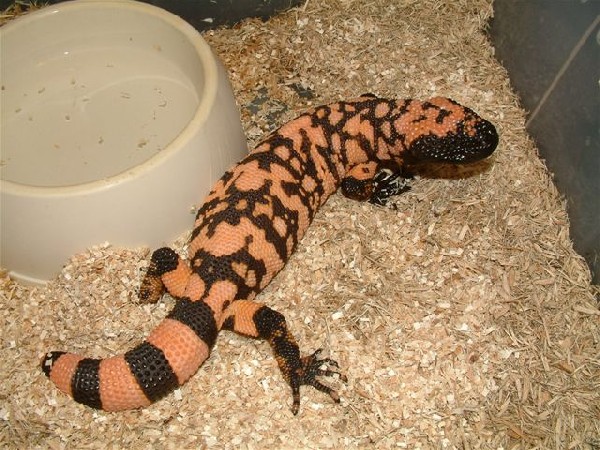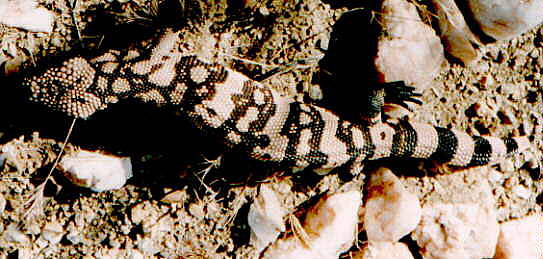|
The Gila Monster (Heloderma suspectum) Captive Care and Breeding This article (slightly edited) appeared in the May/June 1998 issue of Reptile and Amphibian Magazineby Petra Spiess The gila monster (Heloderma suspectum) is one reptile that comes with its own mythos. This species has been widely feared in the southwest, and as a consequence, many interesting (often hilarious) myths have sprung up concerning this species, including the idea that their very breath is toxic! Gila monsters are one of only two venomous lizards in the world, the other being the closely related beaded lizards (Heloderma horridum). As such, many states limit the keeping of this species, so check with local laws before purchasing captive bred gila monsters. Even persons not familiar with reptiles can positively identify a gila monster. Gila monsters are patterned in orange or yellow and black scales that have a "beaded" appearance. This species ranges in size from 9-14 inches (22-35 cm) (Stebbins, 1985). Gila monsters have tongues much like monitor lizards (Varanus sp.) do, which are thick and forked. Gila monster venom is extremely potent, but this animal will not bite unless it is molested. Gila monster venom is delivered via grooves in the animal's teeth, and as such, gila monsters have to chew on their prey items to move the venom into the wound. Sufficed to say, should one ever be bitten by a gila monster, the first order of business is removing the animal. From all reports of gila monster bites, this can prove to be a rather arduous task. The best way to avoid gila monster bites in the wild is to NEVER pick one up. Gila monsters are a protected species in their home states, and there are severe penalties for anyone attempting to capture an animal for a pet or to sell. Gila monsters are diurnal, and are most active in the spring months when there is an abundance of the gila's favorite food, eggs. Eggs from several different species of ground nesting birds make up the majority of the gila monster diet at certain times of the year. Gila monsters are also known to favor the eggs of the desert tortoise (Gopherus agassizii), a federally threatened species. Other wild prey items include small mammals, such as baby rabbits. Gila monster activity patterns are very similar to the patterns of other desert reptiles. During the hot summer months, gila monsters spend a significant portion of their day underground, during the winter months, gila monsters hibernate. Gila monsters may, as desert tortoises do, have a period of activity during the late summer and early fall monsoon months in the Sonoran desert. Although gila monsters are found in the dry Sonoran desert, they are not adapted very well to the low humidity, as their skin is much more permeable than other desert lizard species such as the chuckwalla (Sauromalus obesus). As such, they seem to prefer days where the relative humidity is moderate to high (50-80%) for their activities. Gila monsters are not regularly found roaming about their habitat, so they are difficult to view in the wild. I lived in the Sonoran desert for 13 years, and hiked areas in gila monster habitat extensively for 12 years before I encountered not one, but two individuals out in the open a day apart. I was so excited when I spotted the black and orange figure crossing a dirt road that I grabbed my camera and jumped out my truck in hot pursuit (no pun intended). I shot 36 pictures of the gila monster, with 32 shots of the fleeing animal's rear end making up the majority of my effort. When I returned to my truck after this excursion, I realized that in my excitement, I had forgotten to leave the emergency brake on, because my vehicle was now quite far down the hill from where I had left it. The next day, close to the previous sighting, I spotted another gila monster crossing a different road. Both of these animals fled from my attention at a high rate of speed (for a gila monster). Neither displayed any aggressive behavior, with the exception of a low hissing noise. If cornered however, gila monsters will act out an impressive threat display by facing the threat, opening their mouths wide, hissing loudly, and occasionally jumping at their molester. Both of these animals were observed in the morning hours of late May. The temperature was 75 degrees F (24 degrees C) and the humidity was 60% on both occasions. With only 2 sightings in 13 years, I still consider myself lucky to have observed this animal in the wild at all. Captive Care
The only way to keep a gila monster legally is to purchase captive born offspring, and even then many states regulate or ban their keeping. Gila monsters make interesting and hardy captives. It is best to house animals individually, for ease of feeding. Many breeders have had success however, with a colony approach provided the animals are separated at feeding times, and closely observed during the breeding season to assure the males will not injure each other. Gila monsters are rather large animals, and need large enclosures. The minimum dimensions for an individual gila monster enclosure should be 4 x 2 x 2 ft (1.3 x .66 x .66 m), bigger is always better. Large cattle stock tanks work very well for groups of gilas, as long as ample heat and hiding spots are provided. Gila monster substrates can include playground sand, bark chips, newspaper, or naturalistic substrate. Gila monsters do like to dig; a mixture of playground sand, peat moss, and bark chips, which allows these animals to construct hiding areas, may be among the best of substrate choices. Gilas do well with a thermal gradient of 75-80 degrees F (24-27 degrees C) on the cool end and a warm spot of 85-90 degrees F (29-32 degrees C). Gila monsters also love humidity, and they should be provided with a humidity site. Humidity sites can be constructed out of plastic containers large enough to hold one gila monster. An access hole should be cut into one end of the container and moist peat moss or sphagnum moss placed inside to fill up about half the volume of the box. Gilas will often utilize such areas for a significant portion of the day. Other hiding areas should also be provided, so the animals can choose their preferred environmental conditions. At night, the temperature may be allowed to drop to 70-75 degrees F (21-24 degrees C). Because gila monsters are diurnal, a naturalistic photoperiod should be provided. After hibernation, a schedule of 8 hours of light, 16 hours of darkness increasing over the summer to a max of 14 hours of light, 10 hours of darkness is beneficial (Strimple, 1995). Gila monsters will readily accept rodents of the appropriate size, and should be fed several prey items once or twice a week. After hibernation however, gilas should be fed twice their normal maintenance diet in preparation for the rigors of reproduction. Under no circumstances should gila monsters be feed domestic chicken eggs or chicks. A diet of domestic chicken will result in dietary deficiencies. Although gila monsters are whole-prey eaters in captivity, and thus receive vitamin D3 from the organs of the animals they consume, full-specturm lighting should still be provided as these animals are diurnal, and naturalistic lighting may be beneficial. BreedingGila monster sex is difficult to determine, one method is to watch behavior during the breeding season. If a gila lays an egg, it is female, if it is actively climbing on top of all the other gilas, it is most likely a male (not a very useful method!). Another method that is rather reliable is radiography, and the subsequent noting of the length and width of a particular bone in the pelvic girdle. This has been reported as a reliable way to determine between the sexes (Strimple, 1995), but requires the assistance of a very knowledgeable reptile veterinarian. Recently, DNA analysis has been proposed for sex determination. . Gila monsters should be hibernated to encourage successful reproduction. Two weeks before cooling down, do not feed the breeders, allowing their digestive tracts to clear. After the clearing period, slowly lower the ambient temperature over the period of two weeks until the hibernation temperature of 50-55 degrees F (10-12.7 degrees C) is reached. Make sure to provide hibernating gilas with access to water at all times to prevent dehydration. Many breeders begin the cool-down cycle in November, with the hibernation period lasting until March. The hibernation period should be from two to four months. After the hibernation period, group the animals together in a large "breeding" enclosure. Male gilas will engage in combat, so it is necessary to closely watch the group at this time to make sure no injuries occur. Male to male combat seems to stimulate reproductive activity, with the winning male going on to mate with the females. Removing the males for a few days and reintroducing them often stimulates another round of breeding activity, and can increase the possibility of fertile eggs. Individual pair breeding can also be successful, but many breeders report higher rates of eggs laying and fertile clutches with a breeding group situation. Feed the animals, especially the females, heavily at this time. It is also beneficial to supplement the diet of female gilas with calcium, the rigors of egg production are extremely demanding. Clutch size can range from 2-11 eggs. Gestation runs from 35-55 days. When the female is close to oviposition, she will often shed. This is a signal to move the female into her own quarters and provide an egg-laying chamber. Make sure to check the chamber often, as gila monsters will eat their own eggs. Incubate the eggs in slightly moist vermiculite (1:3 ratio water to vermiculite by weight). Gila monster eggs do not tolerate very high humidity, and are prone to fungal attacks. The humidity in the incubator should be 50-60%. A good indicator of humidity needs are the eggs themselves, if they begin to dent in, add a little water around the vermiculite. Incubation temperatures should range from 78-82 degrees F (25.5-27.7). The eggs generally hatch in 120-150 days. Right before hatching, the eggs will "cave in" and the skin of the hatchling may be visible through the shell. Neonate gilas should be housed individually, and offered the same environmental conditions as the adults. Gila monsters are a fantastic species to keep and breed, however, only experienced herpetoculturists should keep venomous species. The gila monster although "slow" in comparison to most venomous snakes, still has a dangerously toxic venom and should be respected accordingly. References Stebbins, Robert C. 1985. Western Reptiles and Amphibians. Houghton Mifflin Company. New York, NY. Strimple, Pete. 1995. "Captive Reproduction of Gila Monsters A Review". Reptiles. Acknowlegements I would like to thank Matt Smith for his input on the husbandry of gila monsters
|
Recent Gila & Beaded Lizard Classifieds: |
